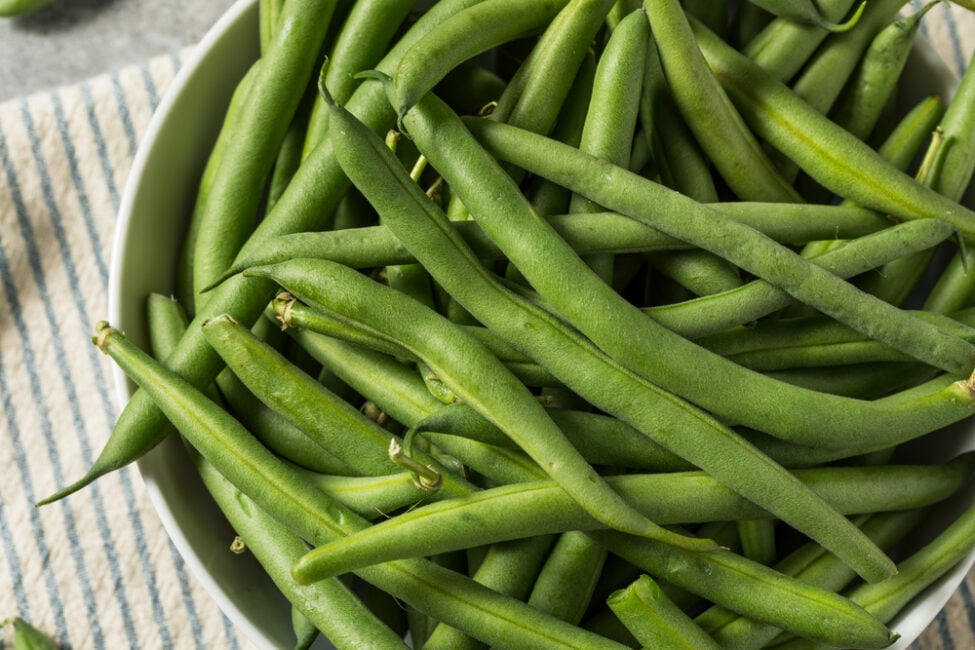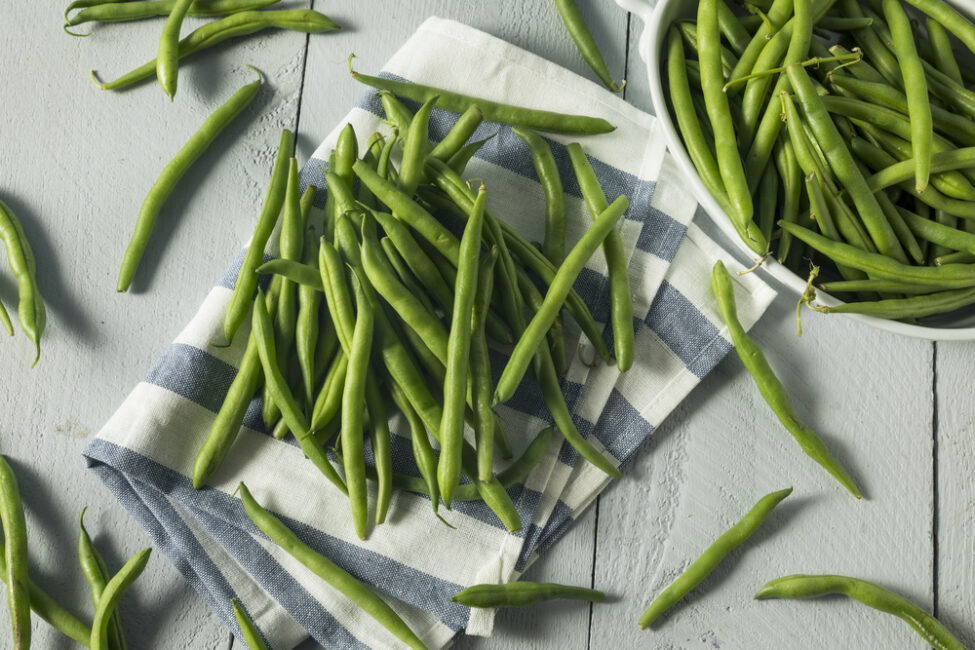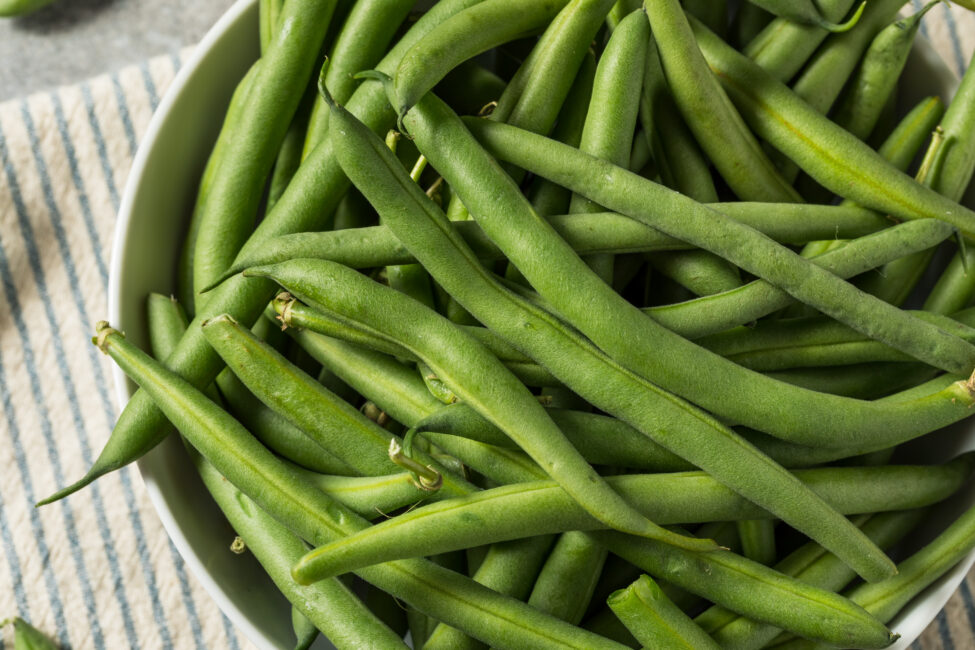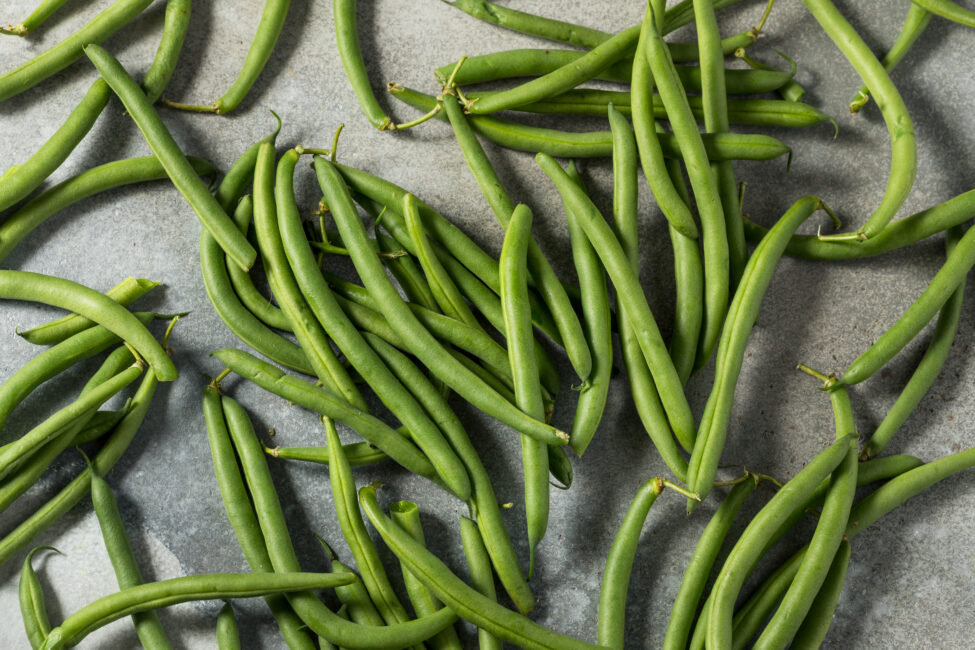This post may contain affiliate links. Please read our
disclosure policy
for more information.
If I had a nickel for every time I found myself staring at a bag of green beans, wondering if they’re still good or if they’ve moved onto Veggie Valhalla… I’d have a lot of nickels. I swear sometimes they change their status from “crisp and vibrant” to “questionably limp” overnight.
If you were a fly on the wall of my kitchen, you’d hear me regularly say, “What do you mean I’ve had this bag for weeks? I just bought it 2 days ago!” Then a disembodied narrator would chime in: “Unbeknownst to Jaden, the bag of green beans was indeed bought weeks ago.”
To save you from enduring this culinary conundrum, we’re diving deep into the cold, crisp world of green beans and talking about the best ways to make them stay more “gourmet” and less “garden compost.”

How Long Do Green Beans Last in the Fridge?
If you’re looking for the quick answer: about a week. But, as with most things in the kitchen, there’s a bit more to keeping them fresh than just tossing them in the crisper and hoping for the best.
Stick around, and I’ll spill the beans on how to keep these green beans… well… green.
Factors That Affect The Fridge Life of Your Green Beans
The shelf life of green beans depends on several factors.
Where Are They From?: It might seem silly, but we have to consider the origin story of our beloved green beans (or snap beans or string beans or whatever you like to call them). Whether you purchase beans fresh off the farm stand or the grocery store shelf can play a big part in their longevity.
Green beans from a farmer’s market are often a little more resilient thanks to their straight-from-the-source freshness and their peak season availability. And your best option is to obtain whole, untrimmed beans.
How Have They Been Stored?: Leaving your green beans at room temperature for more than a couple of hours could introduce them to harmful bacteria (unless you keep your home at a brisk 45°F temp, which, let’s face it… most of us do not). Your fridge will provide them with a cool, dry place where they can live their best life.
Of course, you’ll want to be mindfully of where you’re storing them in the fridge. A bag of fresh green beans thrown haphazardly next to last night’s spicy curry might absorb some unwanted flavors, so make sure you’re storing them in the best place. While some may swear by airtight containers as the end-all be-all for freshness, green beans, like many other fresh vegetables, prefer to breathe.
To maintain the freshest green beans, remove any brown or rotting beans and stash the rest unwashed in an open bag or deli tray, and place them in your crisper.
When you’re ready to use them, be sure to wash them first in cool running water.

Signs That Green Beans Have Gone Bad
The telltale signs of green bean spoilage are hard to miss once you know what you’re looking for. And you have everything you need. You were built to be a bad green bean detector!
In all seriousness, all you have to do is use your senses to find out if those green beans are well past their prime.
Sight: If your beans have lost their vibrant green color or you notice brown spots, that’s a good indicator that your once delicious green beans are starting their journey to the dark side.
Touch: Slimy green beans or ones that have lost their firm texture are definitely a reg flag that your beans have seen better days.
Scent: If sniffing your beans evokes a facial expression similar to tasting a lemon for the first time, it’s time to chuck them in the trash.
While eating spoiled green beans might not send you on a trip to the ER, it’s not going to do your digestive system any favors either. The risk of foodborne illness increases with spoilage, so it’s best to play it safe. Remember the golden rule: when in doubt, it’s a good idea to throw it out. Your stomach will thank you!

How to Maximize the Shelf Life of Your Beans
Freezing green beans is a great way to hit the pause button on their freshness. But first, you will need to blanch them. To do this right, give them a quick boil in salted water before plunging them into an ice bath.
This process will help you to maintain their freshness and crisp texture. Once they’re dry, spread them out in a single layer on a baking sheet and freeze them. After they’re frozen, you can transfer them to a freezer-safe bag. This method will prevent your beans from turning into a green bean ice block.
When properly stored, frozen green beans can last for 10 to 12 months. Be sure to to label your bags with the date for future use!
You can safely thaw your green beans by transferring them to the fridge for an overnight stay or use them directly from the freezer when you cook.

Ways To Use Up Green Beans Before They Give Up The Ghost
Before your greens take a turn for the worse, get a little creative in the kitchen! Toss them into a green bean salad with some olive oil, fresh herbs, and salt for a healthy lunch.
Or, how about a stir-fry? When sautéed on high heat with some olive oil and your favorite spices, green beans can add a crunchy lil twist to your meal. Or, if you’re a condiment queen like me and you love a good dip, why not blend them into a vibrant green bean hummus?
FAQs
How do I choose the best quality green beans at the farmers market or grocery store?
When hunting for the freshest green beans, keep your eyes peeled for that vibrant green color. They should also have a firm texture, and no visible brown spots or signs of wilting. When bent, the beans should have a snappy quality.
For the best options, shop during the peak season of green beans, which is typically during summer and early fall. You’ll be able to tell which were recently harvest, by looking at the ends of the beans, which will be intact, and the surface, which should be smooth.
Can I eat green beans that have been in the fridge for over a week?
While green beans can last up to a week in the fridge, after that, it’s really important to take a second look. Check for signs of spoilage like brown spots or a slimy texture. If they seem off, even in the slightest, it’s best to toss them.
What’s the best way to prevent freezer burn when storing green beans for an extended period of time?
To shield your green beans from freezer burn, minimize their exposure to air. Start by blanching your beans in boiling water, then dunk them in a bowl of ice water to stop the cooking process. Dry them thoroughly to prevent ice crystals from forming, and then place them in freezer-safe bags, squeezing out as much air as possible before sealing.
Can I freeze green beans without blanching them first?
While you can freeze green beans without blanching first, this can poorly affect their texture and flavor. Blanching before you freeze your green beans helps to preserve their vibrant green color, crisp texture, fresh flavor, and nutritional value.
What if I grow my own green beans?
For you green-thumb gurus who grow your own green beans (bravo, by the way), the same rules apply. To best respect all the hard work and care you’ve put into growing them, keep them cool, dry, and in a well-ventilated bag.

Get Beanin’!
With these tips, you’ll now be able to keep your green beans as fresh as possible.
Got any green bean secrets of your own? Or a green bean recipe that’s to die for? Comment below with your tips, tricks, or favorite green bean casserole experience!
Want More Tips & Tricks?
This post may contain affiliate links. Please read our
disclosure policy
for more information.
This post may contain affiliate links. Please read our
disclosure policy
for more information.
If I had a nickel for every time I found myself staring at a bag of green beans, wondering if they’re still good or if they’ve moved onto Veggie Valhalla… I’d have a lot of nickels. I swear sometimes they change their status from “crisp and vibrant” to “questionably limp” overnight.
If you were a fly on the wall of my kitchen, you’d hear me regularly say, “What do you mean I’ve had this bag for weeks? I just bought it 2 days ago!” Then a disembodied narrator would chime in: “Unbeknownst to Jaden, the bag of green beans was indeed bought weeks ago.”
To save you from enduring this culinary conundrum, we’re diving deep into the cold, crisp world of green beans and talking about the best ways to make them stay more “gourmet” and less “garden compost.”

How Long Do Green Beans Last in the Fridge?
If you’re looking for the quick answer: about a week. But, as with most things in the kitchen, there’s a bit more to keeping them fresh than just tossing them in the crisper and hoping for the best.
Stick around, and I’ll spill the beans on how to keep these green beans… well… green.
Factors That Affect The Fridge Life of Your Green Beans
The shelf life of green beans depends on several factors.
Where Are They From?: It might seem silly, but we have to consider the origin story of our beloved green beans (or snap beans or string beans or whatever you like to call them). Whether you purchase beans fresh off the farm stand or the grocery store shelf can play a big part in their longevity.
Green beans from a farmer’s market are often a little more resilient thanks to their straight-from-the-source freshness and their peak season availability. And your best option is to obtain whole, untrimmed beans.
How Have They Been Stored?: Leaving your green beans at room temperature for more than a couple of hours could introduce them to harmful bacteria (unless you keep your home at a brisk 45°F temp, which, let’s face it… most of us do not). Your fridge will provide them with a cool, dry place where they can live their best life.
Of course, you’ll want to be mindfully of where you’re storing them in the fridge. A bag of fresh green beans thrown haphazardly next to last night’s spicy curry might absorb some unwanted flavors, so make sure you’re storing them in the best place. While some may swear by airtight containers as the end-all be-all for freshness, green beans, like many other fresh vegetables, prefer to breathe.
To maintain the freshest green beans, remove any brown or rotting beans and stash the rest unwashed in an open bag or deli tray, and place them in your crisper.
When you’re ready to use them, be sure to wash them first in cool running water.

Signs That Green Beans Have Gone Bad
The telltale signs of green bean spoilage are hard to miss once you know what you’re looking for. And you have everything you need. You were built to be a bad green bean detector!
In all seriousness, all you have to do is use your senses to find out if those green beans are well past their prime.
Sight: If your beans have lost their vibrant green color or you notice brown spots, that’s a good indicator that your once delicious green beans are starting their journey to the dark side.
Touch: Slimy green beans or ones that have lost their firm texture are definitely a reg flag that your beans have seen better days.
Scent: If sniffing your beans evokes a facial expression similar to tasting a lemon for the first time, it’s time to chuck them in the trash.
While eating spoiled green beans might not send you on a trip to the ER, it’s not going to do your digestive system any favors either. The risk of foodborne illness increases with spoilage, so it’s best to play it safe. Remember the golden rule: when in doubt, it’s a good idea to throw it out. Your stomach will thank you!

How to Maximize the Shelf Life of Your Beans
Freezing green beans is a great way to hit the pause button on their freshness. But first, you will need to blanch them. To do this right, give them a quick boil in salted water before plunging them into an ice bath.
This process will help you to maintain their freshness and crisp texture. Once they’re dry, spread them out in a single layer on a baking sheet and freeze them. After they’re frozen, you can transfer them to a freezer-safe bag. This method will prevent your beans from turning into a green bean ice block.
When properly stored, frozen green beans can last for 10 to 12 months. Be sure to to label your bags with the date for future use!
You can safely thaw your green beans by transferring them to the fridge for an overnight stay or use them directly from the freezer when you cook.

Ways To Use Up Green Beans Before They Give Up The Ghost
Before your greens take a turn for the worse, get a little creative in the kitchen! Toss them into a green bean salad with some olive oil, fresh herbs, and salt for a healthy lunch.
Or, how about a stir-fry? When sautéed on high heat with some olive oil and your favorite spices, green beans can add a crunchy lil twist to your meal. Or, if you’re a condiment queen like me and you love a good dip, why not blend them into a vibrant green bean hummus?
FAQs
How do I choose the best quality green beans at the farmers market or grocery store?
When hunting for the freshest green beans, keep your eyes peeled for that vibrant green color. They should also have a firm texture, and no visible brown spots or signs of wilting. When bent, the beans should have a snappy quality.
For the best options, shop during the peak season of green beans, which is typically during summer and early fall. You’ll be able to tell which were recently harvest, by looking at the ends of the beans, which will be intact, and the surface, which should be smooth.
Can I eat green beans that have been in the fridge for over a week?
While green beans can last up to a week in the fridge, after that, it’s really important to take a second look. Check for signs of spoilage like brown spots or a slimy texture. If they seem off, even in the slightest, it’s best to toss them.
What’s the best way to prevent freezer burn when storing green beans for an extended period of time?
To shield your green beans from freezer burn, minimize their exposure to air. Start by blanching your beans in boiling water, then dunk them in a bowl of ice water to stop the cooking process. Dry them thoroughly to prevent ice crystals from forming, and then place them in freezer-safe bags, squeezing out as much air as possible before sealing.
Can I freeze green beans without blanching them first?
While you can freeze green beans without blanching first, this can poorly affect their texture and flavor. Blanching before you freeze your green beans helps to preserve their vibrant green color, crisp texture, fresh flavor, and nutritional value.
What if I grow my own green beans?
For you green-thumb gurus who grow your own green beans (bravo, by the way), the same rules apply. To best respect all the hard work and care you’ve put into growing them, keep them cool, dry, and in a well-ventilated bag.

Get Beanin’!
With these tips, you’ll now be able to keep your green beans as fresh as possible.
Got any green bean secrets of your own? Or a green bean recipe that’s to die for? Comment below with your tips, tricks, or favorite green bean casserole experience!
Want More Tips & Tricks?
This post may contain affiliate links. Please read our
disclosure policy
for more information.










